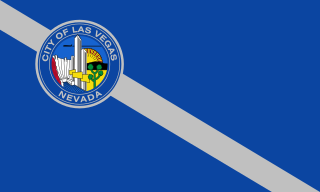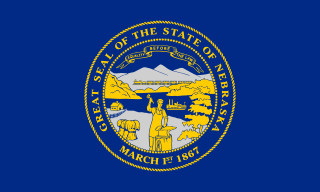
The National Emblem of the People's Republic of China is a national symbol of the People's Republic of China and contains in a red circle a representation of Tiananmen Gate, the entrance gate to the Forbidden City, where Mao Zedong declared the foundation of the People's Republic of China (PRC) in 1949. Above this representation are the five stars found on the national flag. The largest star represents the Chinese Communist Party (CCP), while the four smaller stars represent the four revolutionary social classes as defined in Maoism. The emblem is described as being "composed of patterns of the national flag":
...The red color of the flag symbolizes revolution and the yellow color of the stars the golden brilliant rays radiating from the vast red land. The design of four smaller stars surrounding a bigger one signifies the unity of the Chinese people under the leadership of the Communist Party of China (CPC).
—China Yearbook 2004

The flag of Maine features the state coat of arms on a blue field. In the center of a heraldic shield, a moose rests under a tall pine tree. A farmer and seaman are meant to represent the traditional reliance on agriculture and the sea by the state. The North Star is intended to allude to the state motto: dirigo.

The state flag of the U.S. state of Minnesota consists of a dark blue field representing the night sky and the state's shape, an eight-pointed star representing the North Star, and a bright blue field representing the state's abundant waters; the star is based on one prominently featured in the Minnesota State Capitol rotunda.

The flag of the state of Montana consists of the image of the Montana state seal centered on a blue field.

The flag ofthe state of New Mexico, also referred to as the New Mexican flag, is a State flag, consisting of a sacred red sun symbol of the Zia tribe on a field of gold (yellow). It was officially adopted in March 15, 1925 to highlight the state's Indigenous and Hispanic heritage: it combines the symbol of Puebloan people, who have ancient roots in the state, with the colors of the flag of Spain, symbolizing the Spanish empire, which had established and ruled over “Nuevo México” for over two and a half centuries.

The current flag of South Dakota was adopted in 1992 to represent the U.S. state of South Dakota. It consists of a field of sky blue charged with a version of the state seal in the center, surrounded by gold triangles representing the sun's rays, surrounded in turn by inscriptions in gold sans-serif capitals of "south dakota" on top and "the mount rushmore state" on the bottom. The sun represents the common weather in South Dakota.

The flag of Tennessee displays an emblem on a field of red, with a strip of blue bordered by white on the fly. The emblem in the middle consists of three white stars on a blue circle also with a white border. The central emblem portion of the flag has been adopted as the state's unofficial logo, and appears in the logos of some Tennessee-based companies and sports teams. Examples include the First Horizon Bank and the Tennessee Titans.

The North American Vexillological Association (NAVA) is a membership organization devoted to vexillology, the study of flags. It was founded in 1967 by American vexillologist Whitney Smith, and others. Its membership of 1,100+ comprises flag scholars, enthusiasts, designers, collectors, conservators, educators, merchants, manufacturers, historians, and hobbyists from most states and provinces of the United States and Canada, and more than 30 other countries.

The flag of Indianapolis has a dark blue field with a white five-pointed star pointing upwards in the center. Around the star is a circular field in red. Surrounding the red field is a white ring, from which extend four white stripes from top to bottom and from hoist to fly, thus creating four equal quadrants in the field. The stripes are about one-seventh the width of the flag, with the white ring the same width as the stripes. The diameter of the red circle is about two-ninths the width of the flag.

The flags of New York City include the flag of New York City, the respective flags of the boroughs of The Bronx, Brooklyn, Manhattan, Queens, and Staten Island, and flags of certain city departments. The city flag is a vertical tricolor in blue, white, and orange and charged in the center bar with the seal of New York City in blue. The tricolor design is derived from the flag of the Dutch Monarchy—the Prince's Flag—as used in New Amsterdam in 1625, when that city became the capital of New Netherland.

The city flag of Portland, Oregon, consists of a green field on which is placed a white four-pointed star from which radiate blue stripes, each bordered by L-shaped yellow elements (esquarres). Narrow white fimbriations separate the blue and yellow elements from each other and from the green background. The official ordinance specifies a height of 3 feet and a length of 5 feet for the flag.

The flag of Las Vegas consists of blue field with a diagonal gray stripe running from the top of the hoist to the bottom of the fly. Las Vegas' city seal, adopted on March 16, 1966 and designed by Richard Thompson, is located in the canton breaking the stripe.

The flag of the state of Nebraska is a blue rectangular cloth charged with a variation of the Nebraskan state seal. The current design was commissioned in 1925, when the Nebraska legislature passed a bill stating that the flag would consist of the state seal in gold and silver on a field of blue.

The flag of Phoenix, Arizona contains a maroon field with a white phoenix emblem in the center. Its design is the second in the city's history and has been in place since 1990, replacing a flag that was adopted in 1921.

The flag of Spokane, Washington comprises a sun in the canton on a white-and-green field separated by a stylized blue river. The flag was adopted in 2021 and is the fourth to be used by the city government.

The city flag of San Antonio, Texas was originally drawn by Spanish–American War veteran William W. Herring on May 28, 1933. The design saw significantly more usage than the official flag, but was never officially adopted until 1976. The current flag is a slightly modified version of Herring's design, most notably removing the text formerly displayed.

The current flag of San Jose, California features a triband of gold on top, white in the middle, and blue on the bottom with the city's official seal in the center. It has been the official flag since 1984.

The city flag of Austin, Texas consists of a white field with the seal of Austin without the surrounding circle of text. Below the seal of Austin is the text "CITY OF AUSTIN", written in blue and arched upwards.

The current city flag of Columbus, Ohio is a yellow-white-red vertical triband with the city seal on a blue field. Officially, the flag was adopted in 1929, although it is unknown if the flag was ever flown when it was first adopted.

The flag of Raleigh is the official municipal flag of Raleigh, North Carolina. It is one of the few American city flags to currently feature different designs on the obverse and reverse. Both sides feature a similar red-white-red vertical triband with an emblem in the center. The obverse features the Seal of Raleigh. The reverse has a modified version of the coat of arms of Sir Walter Raleigh.






















